Predicting the Optimum Corn Harvest Time via the Quantity of Dry Matter Determined with Vegetation Indices Obtained from Multispectral Field Imaging
Abstract
1. Introduction
1.1. Remote Sensing
1.2. Field-Wide Image Data Capturing
1.3. Predicting Crop Yield
2. Materials and Methods
2.1. Sensing Periods and Localities
2.2. UAV Data Collection and Analysis
2.2.1. NDVI (Normalized Difference Vegetation Index)
2.2.2. NDRE (Normalized Difference Red Edge Index)
2.2.3. GNDVI (Green Normalized Difference Vegetation Index)
2.3. Chemical Analysis of the Samples Obtained from Field-Gathered Corn Plants
2.4. Data Correlation
2.5. Method to Verify the Resulting Equations: A Separate Corn Field
3. Results
3.1. Chemical Analysis
3.2. Data Correlation Results
3.3. Regression Model Results
3.4. Validating the Regression Models
3.5. Mapping the Vegetation Indices
4. Discussion
4.1. Discussing the Results of the Chemical Analysis
4.2. Discussing the Outcomes of the Chemical Analysis
4.3. Discussing the Results Obtained through Verifying Equations
4.4. Discussing the Results Obtained through Verifying the Equations
4.5. Comparing the Results
4.6. Limitations of the Approach
5. Conclusions
Author Contributions
Funding
Data Availability Statement
Conflicts of Interest
References
- Janoušek, J.; Jambor, V.; Marcoň, P.; Dohnal, P.; Synková, H.; Fiala, P. Using UAV-Based Photogrammetry to Obtain Correlation between the Vegetation Indices and Chemical Analysis of Agricultural Crops. Remote Sens. 2021, 13, 1878. [Google Scholar] [CrossRef]
- Minařík, R.; Langhammer, J.; Lendzioch, T. Detection of Bark Beetle Disturbance at Tree Level Using UAS Multispectral Imagery and Deep Learning. Remote Sens. 2021, 13, 4768. [Google Scholar] [CrossRef]
- Vetrekar, N.T.; Gad, R.S.; Fernandes, I.; Parab, J.S.; Desai, A.R.; Pawar, J.D.; Naik, G.M.; Umapathy, S. Non-invasive hyperspectral imaging approach for fruit quality control application and classification: Case study of apple, chikoo, guava fruits. J. Food Sci. Technol. 2015, 52, 6978–6989. [Google Scholar] [CrossRef]
- Park, B.; Lawrence, K.C.; Windham, W.R.; Smith, D.P. Multispectral imaging system for fecal and igesta detection on poultry carcasses. J. Food Process Eng. 2004, 27, 311–327. [Google Scholar] [CrossRef]
- Cen, H.; Lu, R.; Zhu, Q.; Mendoza, F. Nondestructive detection of chilling injury in cucumber fruit using hyperspectral imaging with feature selection and supervised classification. Postharvest Biol. Technol. 2016, 111, 352–361. [Google Scholar] [CrossRef]
- Lleó, L.; Barreiro, P.; Ruiz-Altisent, M.; Herrero, A. Multispectral images of peach related to firmness and maturity at harvest. J. Food Eng. 2009, 93, 229–235. [Google Scholar] [CrossRef]
- Zhang, H.; Paliwal, J.; Jayas, D.S.; White, N.D.G. Classification of Fungal Infected Wheat Kernels Using Near-Infrared Reflectance Hyperspectral Imaging and Support Vector Machine. Trans. ASABE Am. Soc. Agric. Biol. Eng. 2007, 50, 1779–1785. [Google Scholar] [CrossRef]
- Lukas, V.; Huňady, I.; Kintl, A.; Mezera, J.; Hammerschmiedt, T.; Sobotková, J.; Brtnický, M.; Elbl, J. Using UAV to Identify the Optimal Vegetation Index for Yield Prediction of Oil Seed Rape (Brassica napus L.) at the Flowering Stage. Remote Sens. 2022, 14, 4953. [Google Scholar] [CrossRef]
- Duffková, R.; Poláková, L.; Lukas, V.; Fučík, P. The Effect of Controlled Tile Drainage on Growth and Grain Yield of Spring Barley as Detected by UAV Images, Yield Map and Soil Moisture Content. Remote Sens. 2022, 14, 4959. [Google Scholar] [CrossRef]
- Gracia-Romero, A.; Vergara-Díaz, O.; Thierfelder, C.; Cairns, J.E.; Kefauver, S.C.; Araus, J.L. Phenotyping Conservation Agriculture Management Effects on Ground and Aerial Remote Sensing Assessments of Maize Hybrid Performance in Zimbabwe. Proceedings 2018, 2, 7. [Google Scholar] [CrossRef]
- Yang, B.; Zhu, W.; Rezaei, E.E.; Li, J.; Sun, Z.; Zhang, J. The Optimal Phenological Phase of Maize for Yield Prediction with High-Frequency UAV Remote Sensing. Remote Sens. 2022, 14, 1559. [Google Scholar] [CrossRef]
- Matese, A.; Toscano, P.; Gennaro, S.F.; Genesio, L.; Vaccari, F.P.; Primicerio, J.; Belli, C.; Zaldei, A.; Bianconi, R.; Gioli, B. Intercomparison of UAV, aircraft and satellite remote sensing platforms for precision viticulture. Remote Sens. 2015, 7, 2971–2990. [Google Scholar] [CrossRef]
- Kumar, A.; Desai, S.V.; Balasubramanian, V.N.; Rajalakshmi, P.; Guo, W.; Naik, B.B.; Balram, M.; Desai, U.B. Efficient Maize Tassel-Detection Method using UAV based remote sensing. Remote Sens. Appl. Soc. Environ. 2021, 23, 100549. [Google Scholar] [CrossRef]
- Yao, H.; Qin, R.; Chen, X. Unmanned Aerial Vehicle for Remote Sensing Applications—A Review. Remote Sens. 2019, 11, 1443. [Google Scholar] [CrossRef]
- Su, W.; Zhang, M.; Bian, D.; Liu, Z.; Huang, J.; Wang, W.; Wu, J.; Guo, H. Phenotyping of Corn Plants Using Unmanned Aerial Vehicle (UAV) Images. Remote Sens. 2019, 11, 2021. [Google Scholar] [CrossRef]
- Lei, L.; Qiu, C.; Li, Z.; Han, D.; Han, L.; Zhu, Y.; Wu, J.; Xu, B.; Feng, H.; Yang, H.; et al. Effect of Leaf Occlusion on Leaf Area Index Inversion of Maize Using UAV–LiDAR Data. Remote Sens. 2019, 11, 1067. [Google Scholar] [CrossRef]
- Louis, J.; Pflug, B.; Main-Knorn, M.; Debaecker, V.; Mueller-Wilm, U.; Iannone, R.Q.; Cadau, E.G.; Boccia, V.; Gascon, F. Sentinel-2 Global Surface Reflectance Level-2a Product Generated with Sen2Cor. In Proceedings of the IGARSS 2019—2019 IEEE International Geoscience and Remote Sensing Symposium, Yokohama, Japan, 28 July–2 August 2019; pp. 8522–8525. [Google Scholar] [CrossRef]
- Drusch, M.; Del Bello, U.; Carlier, S.; Colin, O.; Fernandez, V.; Gascon, F.; Hoersch, B.; Isola, C.; Laberinti, P.; Martimort, P.; et al. Sentinel-2: ESA’s Optical High-Resolution Mission for GMES Operational Services. Remote Sens. Environ. 2012, 120, 25–36. [Google Scholar] [CrossRef]
- Islam, M.R.; Garcia, S.C. Prediction of Dry Matter Yield of Hybrid Forage Corn Grown for Silage. Crop Sci. 2014, 54, 2362–2372. [Google Scholar] [CrossRef]
- Huang, J.; Wang, H.; Dai, Q.; Han, D. Analysis of NDVI Data for Crop Identification and Yield Estimation. IEEE J. Sel. Top. Appl. Earth Obs. Remote Sens. 2014, 7, 4374–4384. [Google Scholar] [CrossRef]
- Wang, J.; Rich, P.M.; Price, K.P.; Kettle, W.D. Relationships between NDVI, Grassland Production, and Crop Yield in the Central Great Plains. Geocarto Int. 2005, 20, 5–11. [Google Scholar] [CrossRef]
- Cabrera-Bosquet, L.; Molero, G.; Stellacci, A.; Bort, J.; Nogués, S.; Araus, J. NDVI as a potential tool for predicting biomass, plant nitrogen content and growth in wheat genotypes subjected to different water and nitrogen conditions. Cereal Res. Commun. 2011, 39, 147–159. [Google Scholar] [CrossRef]
- Sakamoto, T.; Gitelson, A.A.; Arkebauer, T.J. Near real-time prediction of U.S. corn yields based on time-series MODIS data. Remote Sens. Environ. 2014, 147, 219–231. [Google Scholar] [CrossRef]
- Ines, A.V.; Das, N.N.; Hansen, J.W.; Njoku, E.G. Assimilation of remotely sensed soil moisture and vegetation with a crop simulation model for maize yield prediction. Remote Sens. Environ. 2013, 138, 149–164. [Google Scholar] [CrossRef]
- Johnson, D.M. An assessment of pre- and in-season remotely sensed variables for forecasting corn and soybean yields in the United States. Remote Sens. Environ. 2014, 141, 116–128. [Google Scholar] [CrossRef]
- Ma, Y.; Zhang, Z.; Kang, Y.; Özdoğan, M. Corn yield prediction and uncertainty analysis based on remotely sensed variables using a Bayesian neural network approach. Remote Sens. Environ. 2021, 259, 112408. [Google Scholar] [CrossRef]
- de Oliveira, M.F.; Ortiz, B.V.; Morata, G.T.; Jiménez, A.-F.; Rolim, G.D.S.; da Silva, R.P. Training Machine Learning Algorithms Using Remote Sensing and Topographic Indices for Corn Yield Prediction. Remote Sens. 2022, 14, 6171. [Google Scholar] [CrossRef]
- Tang, Z.; Guo, J.; Xiang, Y.; Lu, X.; Wang, Q.; Wang, H.; Cheng, M.; Wang, H.; Wang, X.; An, J.; et al. Estimation of Leaf Area Index and Above-Ground Biomass of Winter Wheat Based on Optimal Spectral Index. Agronomy 2022, 12, 1729. [Google Scholar] [CrossRef]
- Muruganantham, P.; Wibowo, S.; Grandhi, S.; Samrat, N.H.; Islam, N. A Systematic Literature Review on Crop Yield Prediction with Deep Learning and Remote Sensing. Remote Sens. 2022, 14, 1990. [Google Scholar] [CrossRef]
- van Klompenburg, T.; Kassahun, A.; Catal, C. Crop Yield Prediction Using Machine Learning: A Systematic Literature Review. Comput. Electron. Agric. 2020, 177, 105709. [Google Scholar] [CrossRef]
- Khalil, Z.H.; Abdullaev, S.M. Neural Network for Grain Yield Predicting Based Multispectral Satellite Imagery: Comparative Study. Procedia Comput. Sci. 2021, 186, 269–278. [Google Scholar] [CrossRef]
- Pant, J.; Pant, R.P.; Kumar Singh, M.; Pratap Singh, D.; Pant, H. Analysis of Agricultural Crop Yield Prediction Using Statistical Techniques of Machine Learning. Mater. Today Proc. 2021, 46, 10922–10926. [Google Scholar] [CrossRef]
- Ilyas, Q.; Ahmad, M.; Mehmood, A. Automated Estimation of Crop Yield Using Artificial Intelligence and Remote Sensing Technologies. Bioengineering 2023, 10, 125. [Google Scholar] [CrossRef]
- Wang, R.; Cherkauer, K.; Bowling, L. Corn Response to Climate Stress Detected with Satellite-Based NDVI Time Series. Remote Sens. 2016, 8, 269. [Google Scholar] [CrossRef]
- Mkhabela, M.S.; Mkhabela, M.S.; Mashinini, N.N. Early maize yield forecasting in the four agro-ecological regions of Swaziland using NDVI data derived from NOAA’s-AVHRR. Agric. For. Meteorol. 2005, 129, 1–9. [Google Scholar] [CrossRef]
- Coelho, A.P.; Rosalen, D.L.; Faria, R.T. Vegetation indices in the prediction of biomass and grain yield of white oat under irrigation levels. Trop. Agric. Res. 2018, 48, 109–117. [Google Scholar] [CrossRef]
- Bretas, I.L.; Valente, D.S.; Silva, F.F.; Chizzotti, M.L.; Paulino, M.F.; D’áurea, A.P.; Paciullo, D.S.; Pedreira, B.C.; Chizzotti, F.H. Prediction of aboveground biomass and dry-matter content in Brachiaria pastures by combining meteorological data and satellite imagery. Grass Forage Sci. 2021, 76, 340–352. [Google Scholar] [CrossRef]
- Svotwa, E.; Masuka, J.A.; Maasdorp, B.; Murwira, A. Spectral Indices: In-Season Dry Mass and Yield Relationship of Flue-Cured Tobacco under Different Planting Dates and Fertiliser Levels. Int. Sch. Res. Not. 2013, 2013, 816767. [Google Scholar] [CrossRef]
- Maresma, A.; Chamberlain, L.; Tagarakis, A.; Kharel, T.; Godwin, G.; Czymmek, K.J.; Shields, E.; Ketterings, Q.M. Accuracy of NDVI-derived corn yield predictions is impacted by time of sensing. Comput. Electron. Agric. 2020, 169, 105236. [Google Scholar] [CrossRef]
- Rahetlah, B.V.; Salgado, P.; Andrianarisoa, B.; Tillard, E.; Razafindrazaka, H.; Le Mezo, L.; Ramalanjaona, V.L. Relationship between normalized difference vegetation index (NDVI) and forage biomass yield in the Vakinankaratra region, Madagascar. Livest. Res. Rural. Dev. 2014, 26, 1–11. [Google Scholar]
- Gerighausen, H.; Lilienthal, H.; Jarmer, T.; Siegmann, B. Evaluation of leaf area index and dry matter predictions for crop growth modelling and yield estimation based on field reflectance measurements. eARSeL eProceedings 2016, 14, 71–90. [Google Scholar]
- Junior, A.S.D.A.; Melo, F.D.B.; Bastos, E.A.; Cardoso, M.J. Evaluation of The Nutritional Status of Corn by Vegetation Indices Via Aerial Images. Ciência Rural 2021, 51, 1–13. [Google Scholar] [CrossRef]
- de Souza, R.; Peña-Fleitas, M.T.; Thompson, R.B.; Gallardo, M.; Padilla, F.M. Assessing Performance of Vegetation Indices to Estimate Nitrogen Nutrition Index in Pepper. Remote Sens. 2020, 12, 763. [Google Scholar] [CrossRef]
- Flores, M.D.S.; Paschoalete, W.M.; Baio, F.H.R.; Campos, C.N.S.; Pantaleão, A.D.A.; Teodoro, L.P.R.; Júnior, C.A.D.S.; Teodoro, P.E. Relationship between Vegetation Indices and Agronomic Performance of Maize Varieties under Different Nitrogen Rates. Biosci. J. 2020, 36, 1638–1644. [Google Scholar] [CrossRef]
- Zhao, X.; Wang, S.L.; Wen, T.; Xu, J.; Huang, B.; Yan, S.; Gao, G.; Zhao, Y.; Li, H.; Qiao, J.; et al. On Correlation between Canopy Vegetation and Growth Indexes of Maize Varieties with Different Nitrogen Efficiencies. Open Life Sci. 2023, 18, 1–12. [Google Scholar] [CrossRef] [PubMed]
- Janse, P.V.; Deshmukh, R.R.; Randive, P.U. Vegetation Indices for Crop Management: A Review. Int. J. Res. Anal. Rev. IJRAR 2019, 6, 1–4. [Google Scholar]
- Price, J. Leaf area index estimation from visible and near-infrared reflectance data. Remote Sens. Environ. 1995, 52, 55–65. [Google Scholar] [CrossRef]
- Panda, S.S.; Ames, D.P.; Panigrahi, S. Application of Vegetation Indices for Agricultural Crop Yield Prediction Using Neural Network Techniques. Remote Sens. 2010, 2, 673–696. [Google Scholar] [CrossRef]
- Xue, J.; Su, B. Significant Remote Sensing Vegetation Indices: A Review of Developments and Applications. J. Sens. 2017, 2017, 1353691. [Google Scholar] [CrossRef]
- Buma, W.G.; Lee, S.-I. Multispectral Image-Based Estimation of Drought Patterns and Intensity around Lake Chad, Africa. Remote Sens. 2019, 11, 21. [Google Scholar] [CrossRef]
- Corrigan, F. Multispectral Imaging Camera Drones in Farming Yield Big Benefits. DroneZon, 2020. Available online: https://www.dronezon.com/learn-about-drones-quadcopters/multispectral-sensor-drones-in-farming-yield-big-benefits/ (accessed on 22 March 2020).
- Cammarano, D.; Fitzgerald, G.; Basso, B.; O’Leary, G.; Chen, D.; Grace, P.; Fiorentino, C. Use of the Canopy Chlorophyll Content Index (CCCI) for Remote Estimation of Wheat Nitrogen Content in Rainfed Environments. Agron. J. 2011, 103, 1597–1603. [Google Scholar] [CrossRef]
- Bausch, W.C.; Halvorson, A.D.; Cipra, J. Quickbird satellite and ground-based multispectral data correlations with agronomic parameters of irrigated maize grown in small plots. Biosyst. Eng. 2008, 101, 306–315. [Google Scholar] [CrossRef]
- Gitelson, A.A.; Merzlyak, M.N. Remote sensing of chlorophyll concentration in higher plant leaves. Adv. Space Res. 1998, 22, 689–692. [Google Scholar] [CrossRef]
- ÚKZÚZ. Methods of Plant Variety State Tests CISTA, Pursuant to the Valid Wording from the Year 1999; ÚKZÚZ: Brno, Czech Republic, 1999. [Google Scholar]
- Achen, C.H. What Does “Explained Variance” Explain? A Reply. Political Anal. 1990, 2, 173–184. [Google Scholar] [CrossRef]
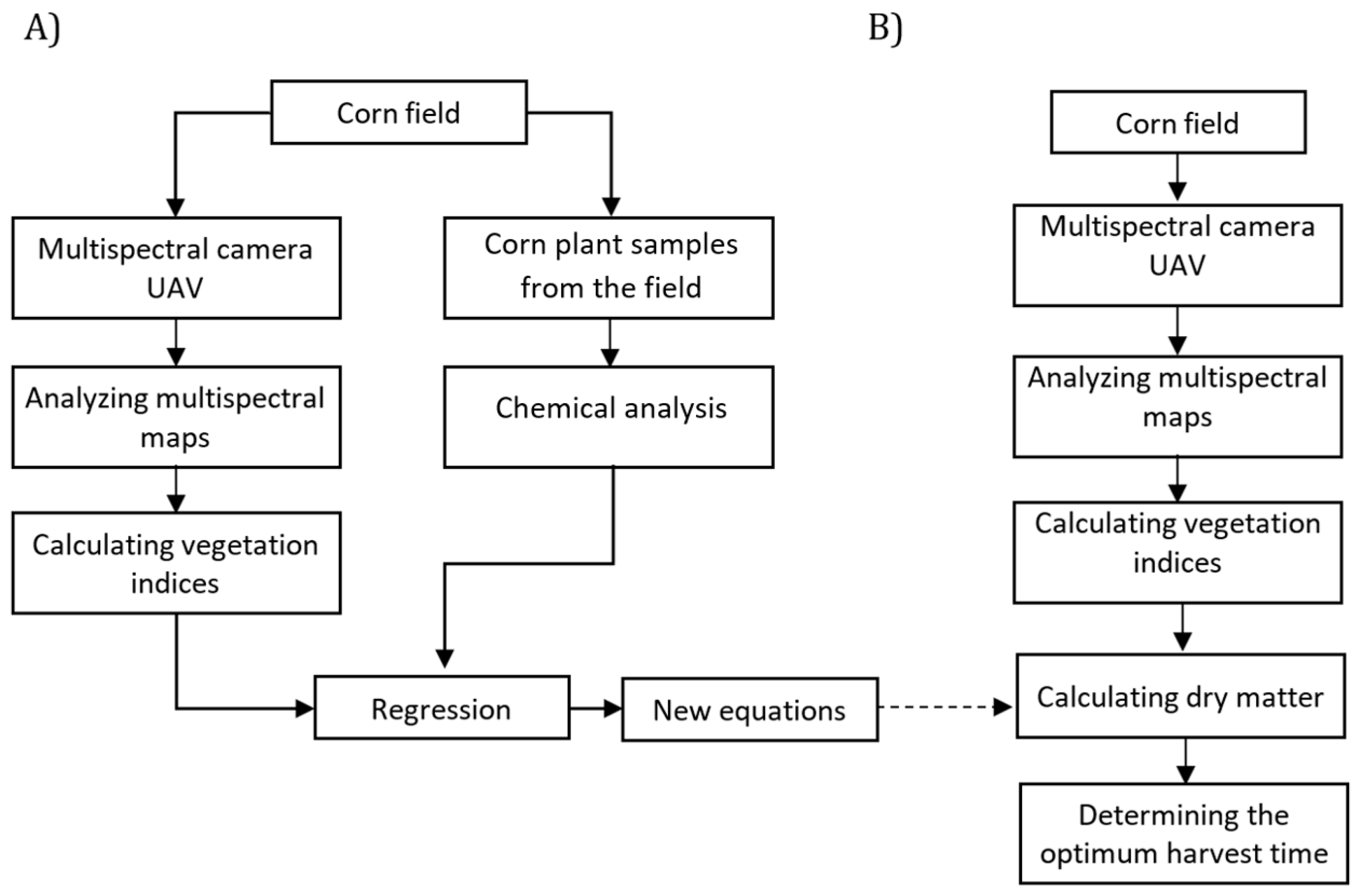
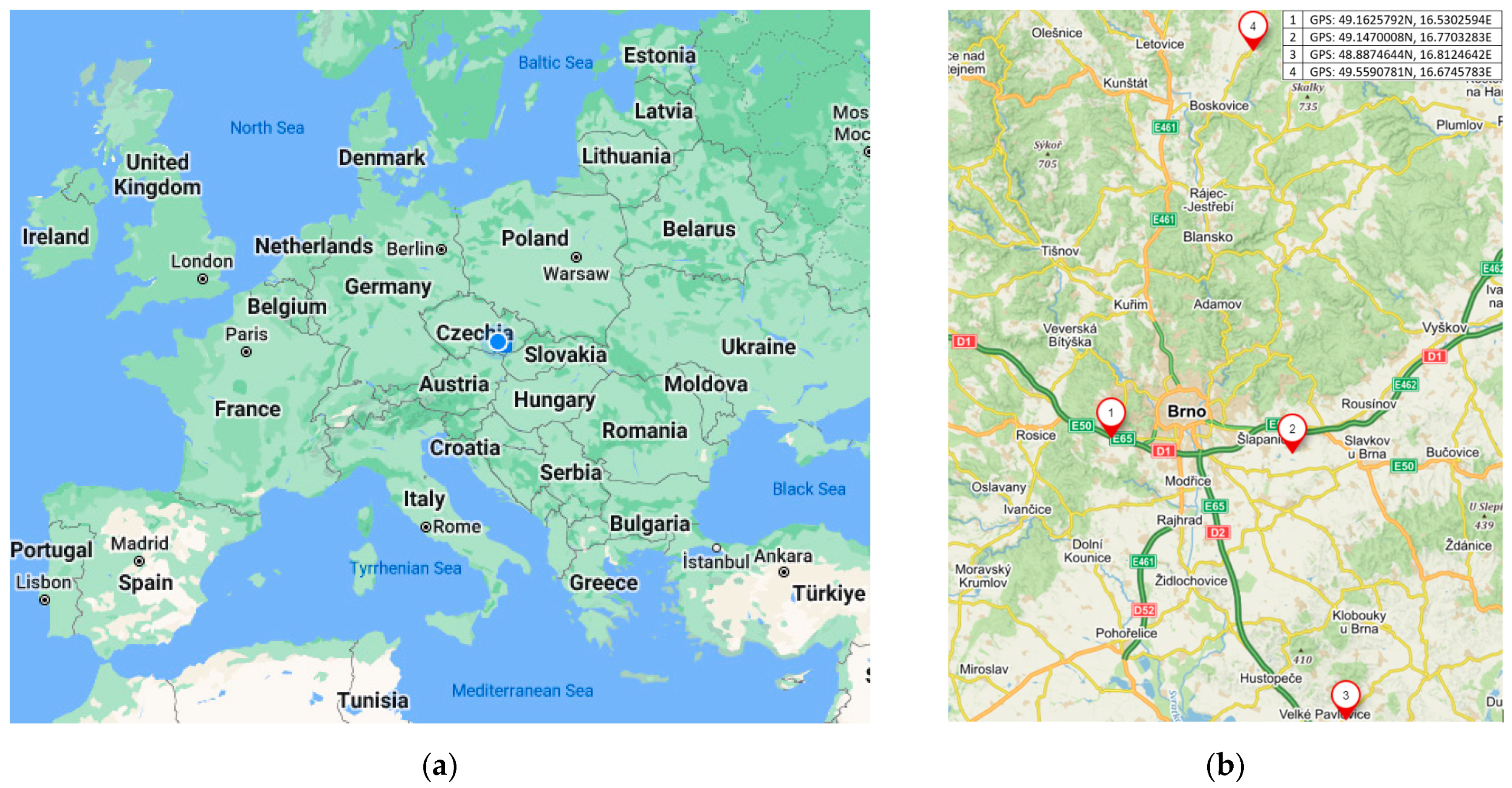
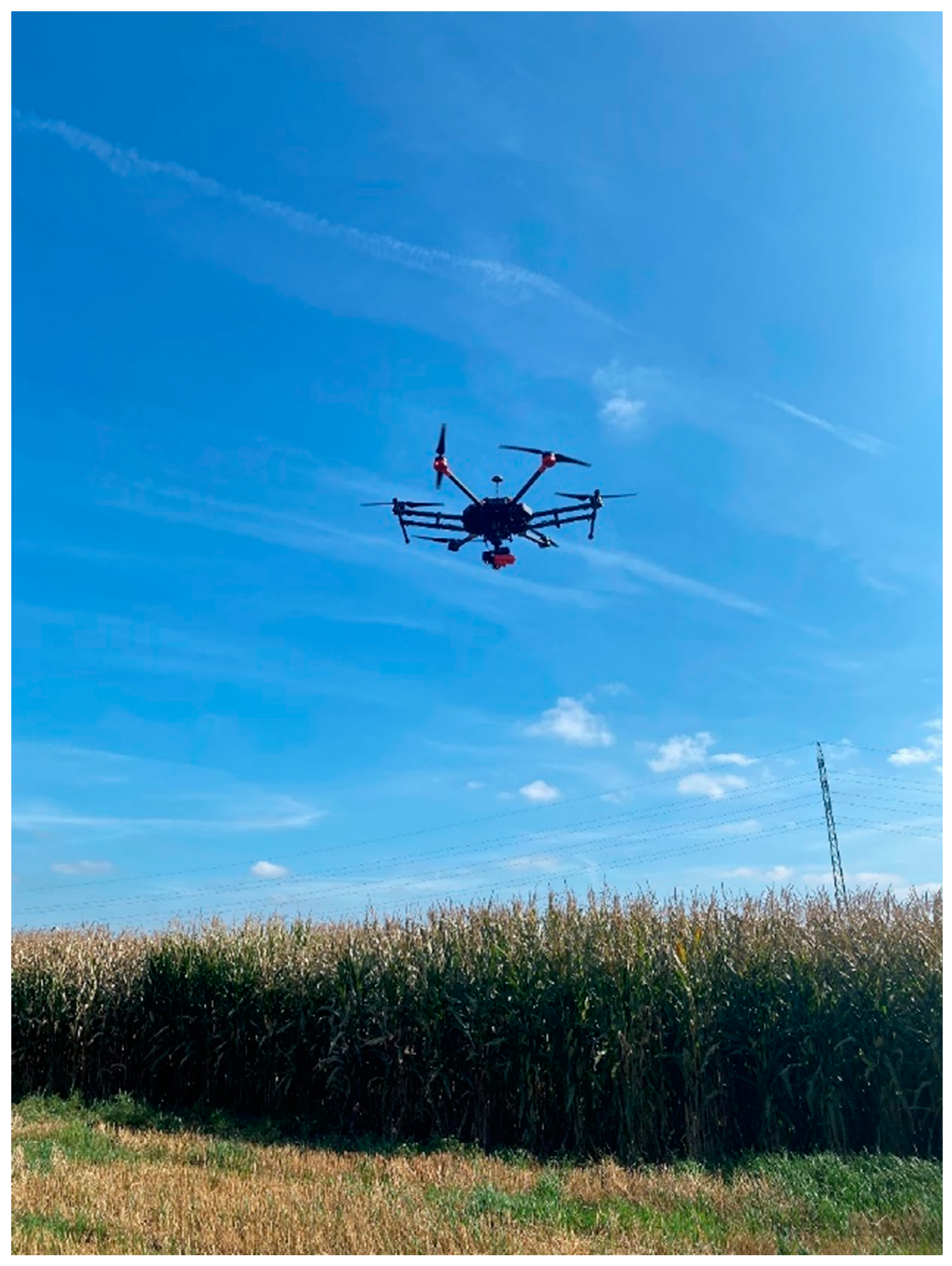

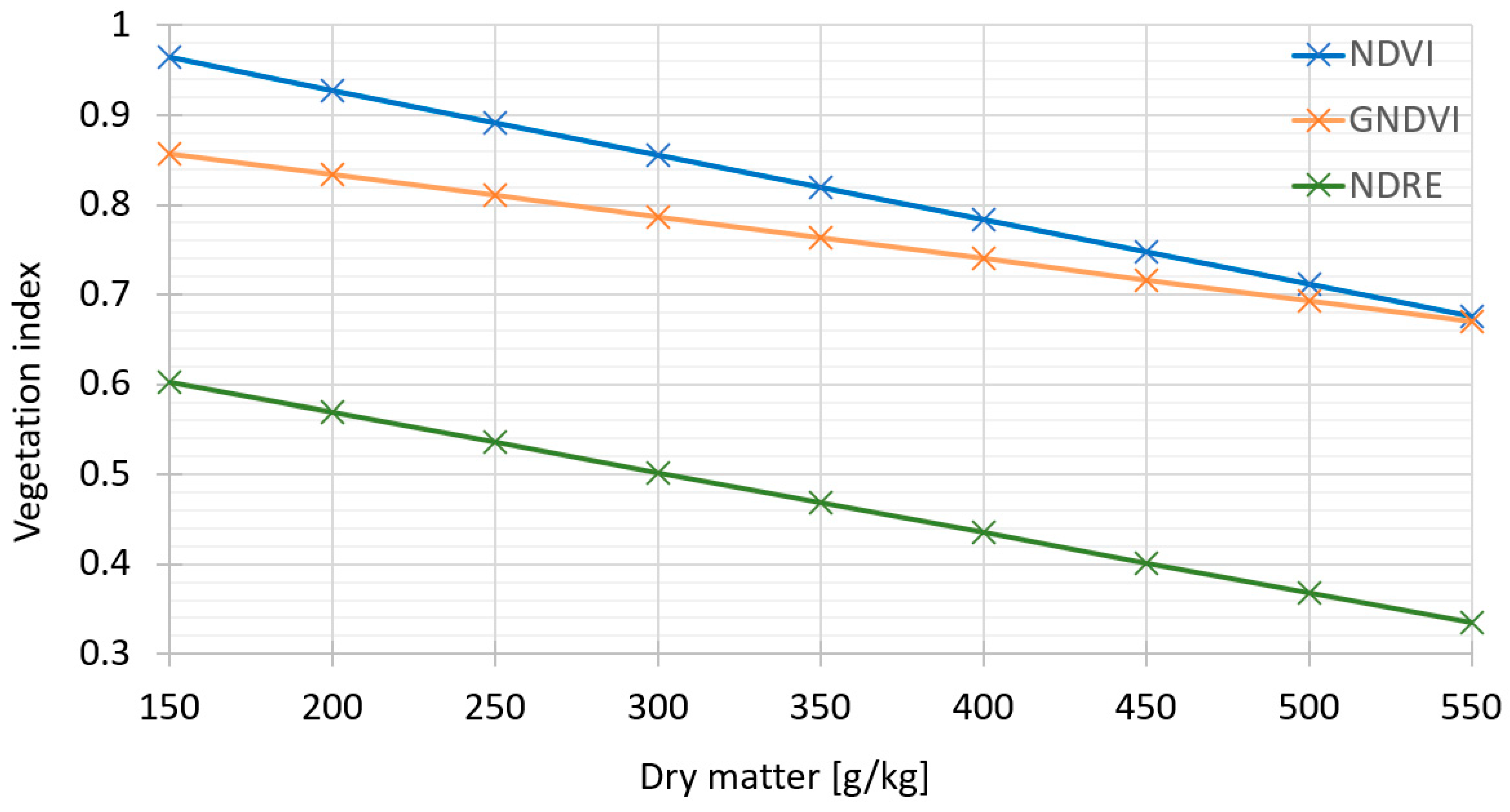
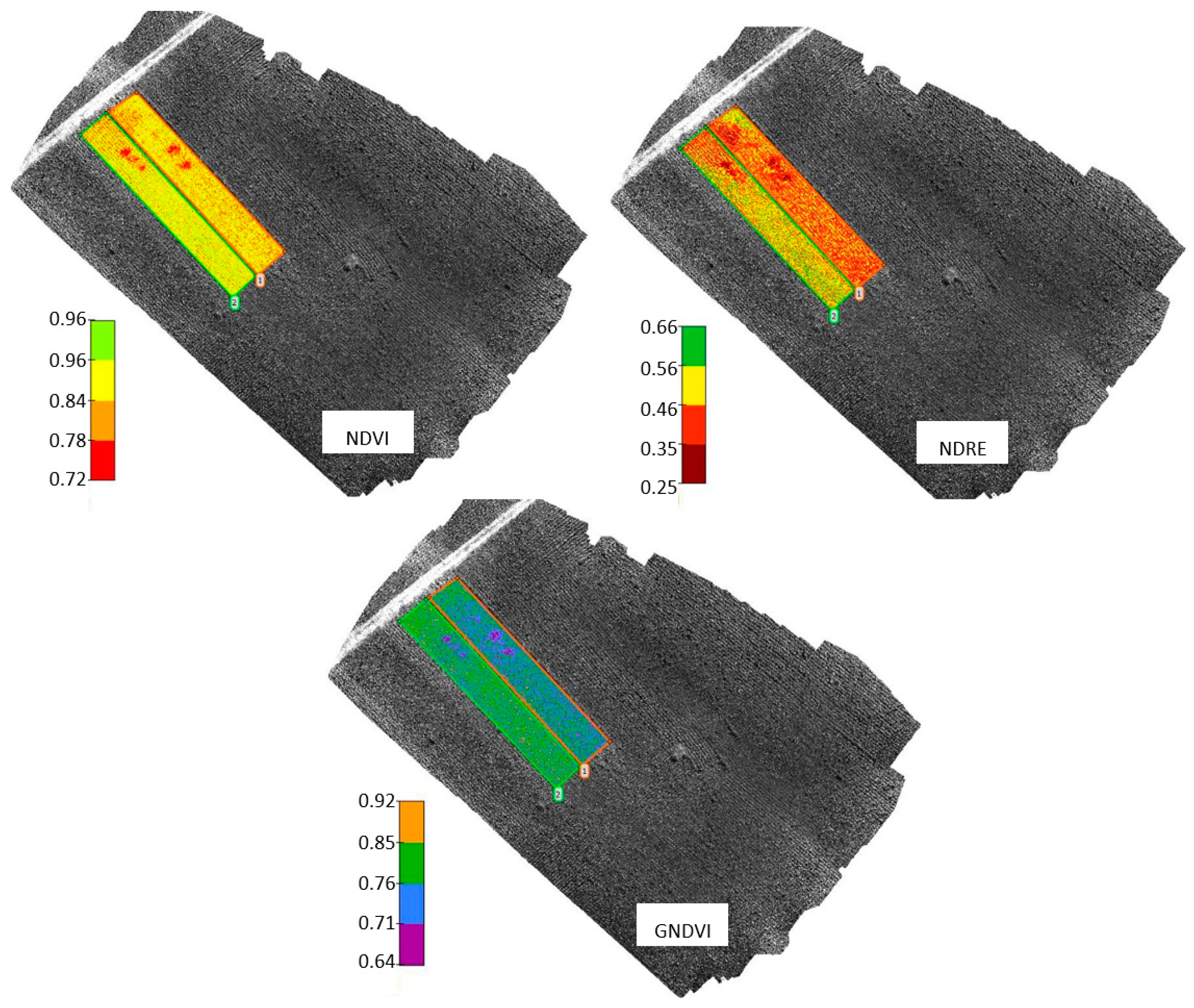
| Band Number | Band Color | Wavelength [nm] | Bandwidth [nm] | Calibration Panel Reflectance |
|---|---|---|---|---|
| 1 | Blue (B) | 475 | 20 | 0.56 |
| 2 | Green (G) | 560 | 20 | 0.56 |
| 3 | Red (R) | 668 | 10 | 0.55 |
| 4 | Near infrared (NIR) | 840 | 40 | 0.54 |
| 5 | Red Edge (RE) | 717 | 10 | 0.50 |
| 2019 Silage Hybrid | Sampling Cases | |||
|---|---|---|---|---|
| 1. | 2. | 3. | 4. | |
| Nutritional Analysis | ||||
| DM [g/kg] | 179.7 | 216.9 | 303.8 | 340.3 |
| CP [g/kg DM] | 117.0 | 93.4 | 81.40 | 94.2 |
| CF [g/kg DM] | 343.3 | 317.6 | 224.7 | 194.1 |
| Starch [g/kg DM] | 10.8 | 13.6 | 17.2 | 29.8 |
| Ash [g/kg DM] | 56.2 | 49.7 | 33.5 | 32.6 |
| NDF [g/kg] | 624.7 | 638.2 | 473.1 | 345.2 |
| 2019 Grain Hybrid | Sampling Cases | ||||
|---|---|---|---|---|---|
| 1. | 2. | 3. | 4. | 5. | |
| Nutritional Analysis | |||||
| DM [g/kg] | 198.4 | 237.0 | 338.6 | 390.8 | 462.5 |
| CP [g/kg DM] | 118.5 | 104.6 | 100.4 | 99.4 | 91.6 |
| CF [g/kg DM] | 312.6 | 304.9 | 226.1 | 329.6 | 320.2 |
| Starch [g/kg DM] | 2.7 | 31.1 | 81.7 | 303.7 | 393.2 |
| Ash [g/kg DM] | 57.0 | 48.1 | 44.6 | 60.3 | 63.9 |
| NDF [g/kg] | 613.4 | 603.7 | 370.5 | 343.8 | 338.4 |
| 2020 Silage Hybrid | Sample Number | |||||||
|---|---|---|---|---|---|---|---|---|
| 1. | 2. | 3. | 4. | 5. | 6. | 7. | 8. | |
| Nutritional Analysis | ||||||||
| DM [g/kg] | 197.2 | 193.2 | 224.4 | 319.7 | 308.8 | 355.7 | 359.4 | 449.5 |
| CP [g/kg DM] | 114.6 | 102.6 | 98.1 | 91.1 | 88.0 | 78.4 | 79.0 | 76.6 |
| CF [g/kg DM] | 364.0 | 335.0 | 306.8 | 238.0 | 250.1 | 198.8 | 223.3 | 225.7 |
| Starch [g/kg DM] | 6.0 | 21.8 | 153.9 | 273.2 | 319.8 | 344.5 | 349.6 | 398.8 |
| Ash [g/kg DM] | 68.4 | 56.5 | 55.8 | 48.4 | 45.7 | 39.0 | 44.0 | 41.4 |
| NDF [g/kg] | 684.1 | 639.6 | 598.6 | 403.0 | 452.4 | 410.0 | 432.3 | 448.1 |
| DNDF [%] | 43.6 | 51.6 | 55.6 | 50.3 | 52.7 | 58.9 | 50.2 | 56.4 |
| DOM [%] | 52.3 | 60.5 | 58.7 | 73.3 | 76.2 | 76.9 | 77.1 | 78.8 |
| Yield Characteristics | ||||||||
| FM [kg/10 plants] | 8.7 | 9.2 | 10.6 | 10.6 | 9.9 | 9.8 | 9.8 | 7.3 |
| EW [kg/10 plants] | NA | NA | NA | 0.0 | NA | 3.4 | 3.6 | 2.9 |
| YFM [kg/ha] | 69,360 | 73,947 | 84,560 | 84,667 | 78,960 | 78,693 | 78,347 | 58,320 |
| YDM [kg/ha] | 13,737 | 14,317 | 18,979 | 27,080 | 24,456 | 28,013 | 28,173 | 26,186 |
| 2021 DKC 3568 | Sample Number | |||||||
|---|---|---|---|---|---|---|---|---|
| 1. | 2. | 3. | 4. | 5. | 6. | 7. | 8. | |
| Nutrition Analysis | ||||||||
| DM [g/kg] | 218.30 | 243.53 | 325.60 | 349.53 | 401.43 | 424.37 | 479.33 | 522.87 |
| CP [g/kg DM] | 105.0 | 93.00 | 72.10 | 72.80 | 70.0 | 68.0 | 65.0 | 65.0 |
| CF [g/kg DM] | 300.0 | 275.5 | 246.2 | 250.2 | 406.3 | 433.6 | 412.7 | 428.5 |
| Starch [g/kg DM] | 15.0 | 27.5 | 81.2 | 208.8 | 250.0 | 300.0 | 350.0 | 380.0 |
| Ash [g/kg DM] | 50.0 | 42.3 | 38.0 | 26.2 | 33.0 | 31.2 | 32.8 | 30.9 |
| NDF [g/kg] | 630.0 | 604.5 | 531.2 | 552.9 | 656.7 | 661.3 | 657.2 | 662.8 |
| DNDF [%] | 55.0 | 58.7 | 51.4 | 48.7 | 25.7 | 24.0 | 22.4 | 26.9 |
| DOM [%] | 70.0 | 72.3 | 74.3 | 67.4 | 41.5 | 41.4 | 41.2 | 44.1 |
| Yield Characteristics | ||||||||
| FM [kg/10 plants] | 7.0 | 6.73 | 6.99 | 5.99 | 5.50 | 5.40 | 5.10 | 4.80 |
| EW [kg/10 plants] | NA | NA | NA | NA | NA | NA | NA | NA |
| YFM [kg/ha] | 56,000 | 53,840 | 55,920 | 47,920 | 44,000 | 43,200 | 40,800 | 38,400 |
| YDM [kg/ha] | 12,225 | 13,112 | 18,208 | 16,750 | 17,663 | 18,333 | 19,557 | 20,078 |
| 2021 DKC 4279 | Sample Number | |||||||
|---|---|---|---|---|---|---|---|---|
| 1. | 2. | 3. | 4. | 5. | 6. | 7. | 8. | |
| Nutrition Analysis | ||||||||
| DM [g/kg] | 213.60 | 228.43 | 256.30 | 294.77 | 338.23 | 357.90 | 389.00 | 470.33 |
| CP [g/kg DM] | 105.0 | 79.2 | 101.8 | 73.3 | 70.0 | 68.0 | 65.0 | 65.0 |
| CF [g/kg DM] | 300.0 | 288.7 | 271.3 | 248.8 | 330.7 | 378.3 | 385.8 | 430.0 |
| Starch [g/kg DM] | 15.0 | 2.6 | 60.3 | 141.7 | 250.0 | 300.0 | 350.0 | 380.0 |
| Ash [g/kg DM] | 50.0 | 53.0 | 53.7 | 41.3 | 31.0 | 32.4 | 37.0 | 35.1 |
| NDF [g/kg] | 630.0 | 572.0 | 578.1 | 487.4 | 545.7 | 597.0 | 616.4 | 687.8 |
| DNDF [%] | 55.0 | 46.5 | 51.0 | 34.9 | 25.3 | 23.8 | 25.4 | 26.5 |
| DOM [%] | 70.0 | 65.6 | 68.3 | 67.7 | 51.1 | 45.7 | 37.9 | 42.3 |
| Yield Characteristics | ||||||||
| FM [kg/10 plants] | 7.0 | 7.53 | 6.29 | 6.87 | 5.50 | 5.40 | 5.10 | 4.80 |
| EW [kg/10 plants] | NA | NA | NA | NA | NA | NA | NA | NA |
| YFM [kg/ha] | 56,000 | 60,240 | 50,320 | 54,960 | 44,000 | 43,200 | 40,800 | 38,400 |
| YDM [kg/ha] | 11,962 | 13,761 | 12,897 | 16,200 | 14,882 | 15,461 | 15,871 | 18,061 |
| Sampling | Vegetation Index | Nutritional Analysis | Yield Characteristics | ||||||
|---|---|---|---|---|---|---|---|---|---|
| DM [g/kg] | CF [g/kg DM] | Starch [g/kg DM] | DNDF [%] | DOM [%] | FM [kg/10 plants] | YFM [kg/ha] | YDM [kg/ha] | ||
| 2019 silage hybrid | NDVI | 2.99 | 2.87 | 10.49 | NA | NA | NA | NA | NA |
| NDRE | 5.16 | 4.74 | 36.40 | NA | NA | NA | NA | NA | |
| GNDVI | 4.05 | 3.65 | 2.18 | NA | NA | NA | NA | NA | |
| 2019 grain hybrid | NDVI | 8.51 | 0.13 | 4.04 | NA | NA | NA | NA | NA |
| NDRE | 11.93 | 0.14 | 4.54 | NA | NA | NA | NA | NA | |
| GNDVI | 12.97 | 0.36 | 7.40 | NA | NA | NA | NA | NA | |
| 2020 silage hybrid | NDVI | 5.74 | 3.24 | 4.62 | 1.67 | 4.19 | 0.99 | 0.99 | 2.87 |
| NDRE | 5.90 | 3.03 | 4.26 | 1.01 | 3.30 | 1.13 | 1.13 | 2.95 | |
| GNDVI | 5.08 | 2.12 | 2.79 | 1.26 | 2.10 | 1.53 | 1.53 | 2.07 | |
| 2021 DKC 3568 | NDVI | 5.42 | 5.51 | 5.51 | 5.45 | 5.21 | 5.69 | 5.69 | 3.00 |
| NDRE | 4.03 | 2.22 | 2.80 | 2.38 | 2.01 | 2.45 | 2.45 | 3.41 | |
| GNDVI | 4.25 | 3.13 | 3.14 | 3.21 | 2.98 | 3.18 | 3.18 | 3.31 | |
| 2021 DKC 4279 | NDVI | 5.63 | 6.36 | 5.23 | 3.00 | 4.60 | 4.70 | 4.70 | 2.76 |
| NDRE | 3.32 | 3.84 | 3.34 | 2.55 | 2.94 | 3.44 | 3.44 | 2.00 | |
| GNDVI | 7.49 | 4.39 | 5.59 | 3.12 | 3.79 | 5.90 | 5.90 | 3.15 | |
| Corn Hybrid Name | Spectral Reflectance | Vegetation Indices | ||||||
|---|---|---|---|---|---|---|---|---|
| B [%] | G [%] | R [%] | RE [%] | NIR [%] | NDVI | NDRE | GNDVI | |
| EC Joker | 4 | 10 | 8 | 25 | 56 | 0.750 | 0.383 | 0.697 |
| EC Wellington | 4 | 10 | 8 | 24 | 55 | 0.746 | 0.392 | 0.692 |
| KTG Karlaxx | 5 | 9 | 7 | 24 | 59 | 0.788 | 0.422 | 0.735 |
| Absolutissimo | 6 | 9 | 7 | 23 | 54 | 0.770 | 0.403 | 0.714 |
| Rudolfinio | 6 | 9 | 7 | 23 | 58 | 0.785 | 0.432 | 0.731 |
| Corn Hybrid | EC Joker | EC Wellington | KTG Karlaxx | Absolutissimo | Rudolfinio | |
|---|---|---|---|---|---|---|
| Nutritional analysis [g/kg] | 459.11 | 470.83 | 383.53 | 423.17 | 398.67 | |
| NDVI | [g/kg] | 458.86 | 464.53 | 404.74 | 429.58 | 409.41 |
| −0.26 | −6.31 | −21.21 | −6.41 | −10.74 | ||
| −0.03 | −1.36 | −5.24 | −1.49 | −2.62 | ||
| NDRE | [g/kg] | 457.69 | 443.85 | 402.02 | 429.29 | 387.14 |
| −1.42 | −26.98 | 18.49 | 6.12 | −11.52 | ||
| −0.31 | −6.08 | 4.60 | 1.43 | −2.98 | ||
| GNDVI | [g/kg] | 461.46 | 470.78 | 384.81 | 426.83 | 392.71 |
| 2.35 | −0.05 | 1.28 | 3.66 | −5.95 | ||
| 0.51 | −0.01 | 0.33 | 0.86 | −1.52 | ||
Disclaimer/Publisher’s Note: The statements, opinions and data contained in all publications are solely those of the individual author(s) and contributor(s) and not of MDPI and/or the editor(s). MDPI and/or the editor(s) disclaim responsibility for any injury to people or property resulting from any ideas, methods, instructions or products referred to in the content. |
© 2023 by the authors. Licensee MDPI, Basel, Switzerland. This article is an open access article distributed under the terms and conditions of the Creative Commons Attribution (CC BY) license (https://creativecommons.org/licenses/by/4.0/).
Share and Cite
Janoušek, J.; Marcoň, P.; Dohnal, P.; Jambor, V.; Synková, H.; Raichl, P. Predicting the Optimum Corn Harvest Time via the Quantity of Dry Matter Determined with Vegetation Indices Obtained from Multispectral Field Imaging. Remote Sens. 2023, 15, 3152. https://doi.org/10.3390/rs15123152
Janoušek J, Marcoň P, Dohnal P, Jambor V, Synková H, Raichl P. Predicting the Optimum Corn Harvest Time via the Quantity of Dry Matter Determined with Vegetation Indices Obtained from Multispectral Field Imaging. Remote Sensing. 2023; 15(12):3152. https://doi.org/10.3390/rs15123152
Chicago/Turabian StyleJanoušek, Jiří, Petr Marcoň, Přemysl Dohnal, Václav Jambor, Hana Synková, and Petr Raichl. 2023. "Predicting the Optimum Corn Harvest Time via the Quantity of Dry Matter Determined with Vegetation Indices Obtained from Multispectral Field Imaging" Remote Sensing 15, no. 12: 3152. https://doi.org/10.3390/rs15123152
APA StyleJanoušek, J., Marcoň, P., Dohnal, P., Jambor, V., Synková, H., & Raichl, P. (2023). Predicting the Optimum Corn Harvest Time via the Quantity of Dry Matter Determined with Vegetation Indices Obtained from Multispectral Field Imaging. Remote Sensing, 15(12), 3152. https://doi.org/10.3390/rs15123152







